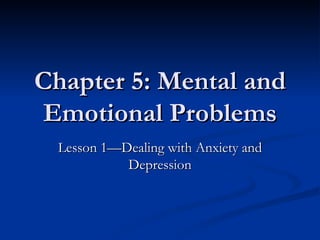Chapter 5: Mental and Emotional Problems
- 1. Chapter 5: Mental and Emotional Problems Lesson 1—Dealing with Anxiety and Depression
- 2. Anxiety v. Depression Anxiety —the condition of feeling uneasy or worried about what may happen Depression —a prolonged feeling of helplessness, hopelessness, and sadness 15% of teens will display some signs of depression Most common mental health concern among teens
- 3. Warning Signs of Depression Persistent sad or irritable mood Loss of interest in activities once enjoyed Significant change in appetite or body weight Difficulty sleeping or oversleeping Physical signs of nervousness Loss of energy Feelings of worthlessness or inappropriate guilt Difficulty concentrating Recurrent thoughts of death or suicide
- 4. Warning Signs of Depression (cont.) Changes in thinking— People who are depressed may have trouble concentrating and making decisions. They may have self-destructive thoughts Changes in feelings— People who are depressed may experience apathy —lack of strong feeling, interest, or concern. They may not feel pleasure in things they once enjoyed. They may be sad, or irritable and angry. Changes in behavior— People with depression may become emotional, and they may begin eating too little or too much. They person may have trouble sleeping and may seem tired. The person may also neglect basic hygiene and withdraw from social situations.
- 5. Chapter 5: Mental and Emotional Problems Lesson 2—Mental Disorders
- 6. Types of Mental Disorders Anxiety Disorders Impulse Control Disorders Eating Disorders Mood Disorders Conduct Disorders Schizophrenia Personality Disorders
- 7. Chapter 5: Mental and Emotional Problems Lesson 3—Suicide Prevention
- 8. Suicide 3 rd leading cause of death for teens ages 15-19. Each year, 17% of all teens in this age group will consider suicide. More than half of that 17% will attempt it. Suicide Risk Factors More than 90% of those who commit suicide are suffering from depression or another mental disorder, or have a history of abusing alcohol or other drugs.
- 9. How Can You Help Your Friends? Initiate a meaningful conversation Show interest, compassion, patience and understanding. Show support and ask questions Remind the person that all problems have solutions, and that suicide is NOT the answer. Try to persuade the person to seek help Encourage the person to talk with a parent, counselor, or trusted adult.
- 10. Chapter 5: Mental and Emotional Problems Lesson 4—Getting Help
- 11. When To Get Help Teens should seek help if they experience any of the following: Feeling trapped or worrying all the time Feelings that affect sleep, eating habits, schoolwork, job performance, or relationships Becoming involved with alcohol or other drugs Becoming increasingly aggressive, violent, or reckless
- 12. Mental Health Professionals Counselor School psychologist Psychiatrist Neurologist Clinical psychologist Psychiatric social worker
- 13. Treatment Methods Psychotherapy Dialogue between a patient and mental health professional Behavior therapy Focuses on changing unwanted behaviors through rewards and reinforcements Cognitive therapy Designed to identify and correct distorted thinking patterns Family therapy Focuses on helping the family function in more positive and constructive ways by exploring patterns in communication and providing support and education Group therapy Treating a group of people who have similar problems Drug therapy The use of certain medications to treat or reduce the symptoms of a mental disorder












